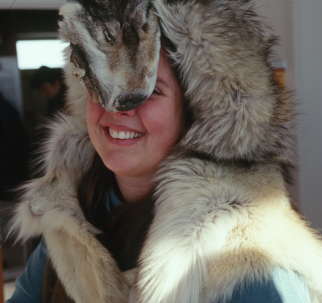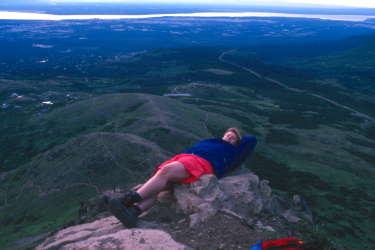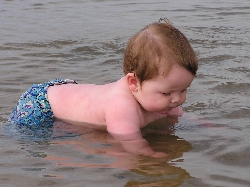


|
Mike Rehberg and Donna Mears
|
||
|
|
~ Saturday, July 17, 2004
Gardening thoughts Looks like weeding and watering and projection of happy thoughts has rapidly transformed our garden from lush and green to lush and green and blooming over the past week. Very happy to walk about and wind down from schoolwork in the yard. Hanging begonias are now blooming up a storm, after consistent watering for a week. This is good, because many of these are replacements for bulbs which dried out over the last winter. Our potted lobelia and alyssum are doing the best yet this year, even in generally shady, small, unfavorable planters. The secret to getting robust lobelia this year, we think, was to buy plugs (20-cent tiny starts) from a local nursery instead of starting from seed. Much cheaper than buying later in cell packs, but much more robust than starting from seed 12 weeks early. First year for petunias. At first, the plants looked spare and unimpressive. However, after a few weeks, they got established and then became massive multi-flowered 8-inch-high plants in many containers. Worth doing again next year. Stick to the richer colors; lavenders and light pinks kind of get lost against the background. Heliotrope has not grown very large at all, but does have small and strongly vanilla-scented flower clusters. Not quite the large plant I expected though. Fewer fuscshia pots this year; they are hard work to keep watered and, frankly, take a really long time to reach the massive bushy clump of flowers that we hope for. Onions(from starts) are doing very well our first time trying them in the warm favored south-facing garden against the garage wall. Finally got good looking garlic this year in the south garden. In fact, we'd left some over the winter by accident - but that was a good accident! Apparently, you are supposed to plant garlic in the fall, let it overwinter, and then harvest it late summer the second year. Nowhere, in any of the Alaska gardening literature, and in fact nowhere on the net, did I ever find clear instructions for growing garlic. (This is a big problem with many gardening resources; the authors make big assumptions - ie, "people should already know that garlic must overwinter".) And of course, the garden centers sell seed bulbs in the spring, so we assumed that's when they get planted. Imagine our surprise when we pulled most of the garlic after a single summer and it had the appearance of leeks - no bulbs at all. Learn by doing I guess... This fall, planting seed garlic recommended to me for our climate by a garlic-only mail-order source. Growing both bush and (for the first time) pole peas this year in the south garden, against a trellis on the garage wall. They never did well in the shady garden. Didn't bother with beans this year after their dismal failure last year. Planted cucumbers from seed in hills in the south garden - instead of trying to grow starts indoors. By growing from seed outside, the plants are much more robust-appearing and have yet to sunburn at all, even with all the hot weather, the way the transplants burned last year. From now on, cukes outdoors from seed. Basil is another plant doing much better as a direct-seed vs. a transplant. Last year, transplanted large basil starts from inside, but they were never vigorous and showed signs of sunburn. This year, planted basil seed direct in south garden. Plants are still quite small, but they are much healthier looking specimens. Hoping for good harvest this fall. Tomatoes doing great this year. Big change - they are all in large pots in the south garden, instead of directly in the planter boxes. Dozens of flowers per plant (Sub-Arctic 25 and Polar Beauty), and I'm happy watching the fat bumble bees fly from flower to flower pollinating them all. Experimental lemongrass in south garden is just sort-of sitting there. This weekend will move it into a planter box and see if it becomes happier. Unfortunately, could not start squash from seed outdoors. The pumpkin seeds we saved from our Halloween pumpkin (bought from Guy Lombardo's farm stand) rotted in the ground without sprouting. We finally bought round zuke starts which are now flowering. From now on, start pumpkins inside. By planting the leeks early, and burying in deep trenches and hilling all the way up to the tops, getting much thicker and satisfying plants than last year. That is, among those 70% that survived the deep transplanting. By planting the potatoes this year deep in trenches, hilling up after emergence, and increasing plant spacing to 12 inches in all directions, we have much more robust plants this year. Better yet, they have not created the tangled mess that we got last year, which I'm sure reduced our yield. Easier to weed and hill as well, much better looking garden. No support required either due to this increased plant spacing. Sometimes intensive gardening can be too intensive. Mostly Idareds, some Yukon Golds, and 4 experimental varieties (German butterball, all-blue, and a couple of others I don't remember). Carrot survival poor this year. Probably because they got overtaken by massive chickweed infestation while we were away in late June, and probably were not well watered at that time. Parsnips look OK from seed; brussels sprouts look very vigorous as well. We're not bothering with cabbage, broccoli or cauliflower - they have never been successful in our relatively shady and moist yard. Ditto lettuce, spinach, other greens. So much can be bought fresh from farmer's market that we now concentrate on what we're good at, and on unusual things that we think would be fun to grow. After removing a moose-girdled tree in the raspberry patch, and fertilizing well this spring, the raspberries have become a monstrous mass. They're suckering as well, which is good - just need to keep them going in the direction we want. Strawberries continue to be a tangled mess intermixed with weed grass... after harvest, we will build a tiered strawberry planter and move them all into it. With our current messy arrangement, most of our fruits become moldy before they ripen. One of 3 rhubarb plants didn't make this winter. Not sure why. Shasta daisy has become a generally unattractive pest plant. We will pull most of it out. It makes massive plants with pretty flowers held on tall - but very weak - stems. The plants bend down under the lawn sprinkler and smother neighboring vegetation. Oh well. Hollyhocks are not flowering yet but the plants are massive. Currants are doing so-so; our one best producer got partially girdled this spring but is doing well so far. Two have herbicide damage caused by overspray from the neighbor's yard. Sawfly infestations of currants and gooseberries were stopped in their tracks by a spinosad spary. Fantastic results from that natural pesticide. New perennial climber on the front yard lamp pole - hops "Wilamette". Slow climbing this year, but then it's getting established. Cosmos planted everywhere and is vigorous; started blooming last week. Godetia is terrible, leggy and still hasn't bloomed. New "Prairie somethingorother" rose is blooming very well on short stems.. I'm sure stems will be much taller next year. Last year's Prairie Dawn is blooming very well also. Annual iceplant is spectacular, bright low showy flowers increasing in number day by day; close during darkness. They make a very showy, low border which complements the generally pale-colored succulent garden near the front walk. One dianthus just started blooming after the others were spent; one succulent now has tall burgundy blooms; primulas stopped blooming 2 weeks ago but made very nice spring shade color; bleeding hearts stopped 2 weeks ago as well; trollius just started a week ago and has showy tall beautiful yellow-orange blooms that work well in dense, green places. Calendulas blooming all over in the south garden; need to transplant them deeper next year because they were leggy coming out of the house and many are kind of floppy in form. First year that we've had good lavender; secret was moving it off the ground and into the boxes of the south garden. Oregano, sage rowing fast. Rosemary taking its sweet time as usual. Thyme turned out to be perennial and is now the anchor for our new perennial herb garden: two thyme bushes (spreading like mad right now), peppermint, spearmint, catnip. Experimental perennial for this winter: sage. Delphinium remains a primadonna when it comes to being watered; they bend over so easily it's frustrating. Starting to think we have a dwarf variety and a tall one; transplants from the neighbor are over 8 feet tall, two transplants from a garden club sale are less than 4 feet tall.
Comments:
Post a Comment
| |